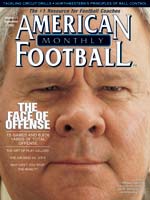AMERICAN FOOTBALL MONTHLY THE #1 RESOURCE FOR FOOTBALL COACHES
Article CategoriesAFM Magazine
|
High Powered Passing Offenses: Why Are They Really Successful?More and More Schools Are Using the Aerial Offense Than Ever Beforeby: Terry Jacoby © More from this issue High-powered, spread-’em-out, throw- the-ball-on-every-position offenses come and go. Or do they? Are aerial offenses that treat a running back with limited respect fads and gimmicks? Or are these offenses formulas for success that can win on a consistent basis over the long term? Keith Simons is one coach with an answer. All he has to do is point to his record. Simons’ Santa Rosa Junior College Bears won the Mid-Empire Conference Championship with an 11-0 record and finished fourth in the nation in 2003. “Basketball on grass,” Simons calls his offensive attack. “It’s a fast-break system in which we don’t huddle and often times have five wideouts spread out over the line of scrimmage. The key is to execute the right play against what we are seeing.” The numbers indicate they’ve been running the right....The full article can only be seen by subscribers. Subscribe today!
|
|
|||||||
| HOME |
MAGAZINE |
SUBSCRIBE | ONLINE COLUMNISTS | COACHING VIDEOS |
Copyright 2025, AmericanFootballMonthly.com
All Rights Reserved





